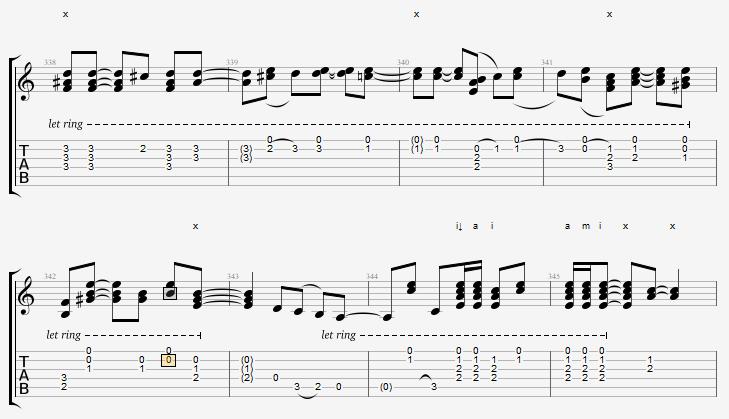|
Ricardo -> RE: Luzia [Book] (Apr. 19 2023 12:49:17)
|
quote:
The question is related to compass and the same chords part (4:17-4:23), though it can be considered a general question. Namely, sometimes a chord gets hit just before the accent (half a measure if that is the correct terminology, or 1/8th note before). For example below, the accent comes at the ^ mark, so the chord is hit just before the accent and then it is let ringing. My question is, would it be a mistake/out of compas if the chord gets hit exactly at the accent spot instead of before, provided the next accent is correct? I guess it would change the shapeof the melody a bit, but I am also curious as to what extent things are allowed or not. I am also thinking that at high speed it's almost not noticeable, or is it?
Ok, sorry. Thought you meant the very next long section. So he is just doing a compas expression similar to the thing Moraito always does accenting 12,2,4,6,8,10. Where you change the chords on 12 or 6, but accent 4 and 10, displacing the count 3 accent (or ignoring it). This means counts 2 and 8 are in the middle of each phrase, also accented and the up beat thing you are concerned about is a big part of how you maintain the groove/soniquete or feeling. If you can HALF time this concept in your brain (where 6,8,10= a half tempo 1,2,3) with 16th note subdivisions (4 per beat, or down-up-down-up strumming), then you need to get used to this expression:
ah-ONE-e…ah-TWO-e…ah-THREE-e…repeat.
That groove is maintaining the feel throughout, with a louder dynamic on the “ah-THREE-e” portion each time, until the special resolution that accents (2)-e….and the decent of melody on 3-e-&-ah also anticipates count 6, or downbeat of the second half of the last compas, which invites the rasgueado on the tonic chord (7-10 basic thing). You should understand in order to play that type of rhythm phrase, you need to always be ON the chord early so not changing chord on the beat, but on the “ah” before it with the up stroke. But those up strokes typically only catch the top two or three treble strings, however, you need to be fingering the full chord.
|
|
|
|

